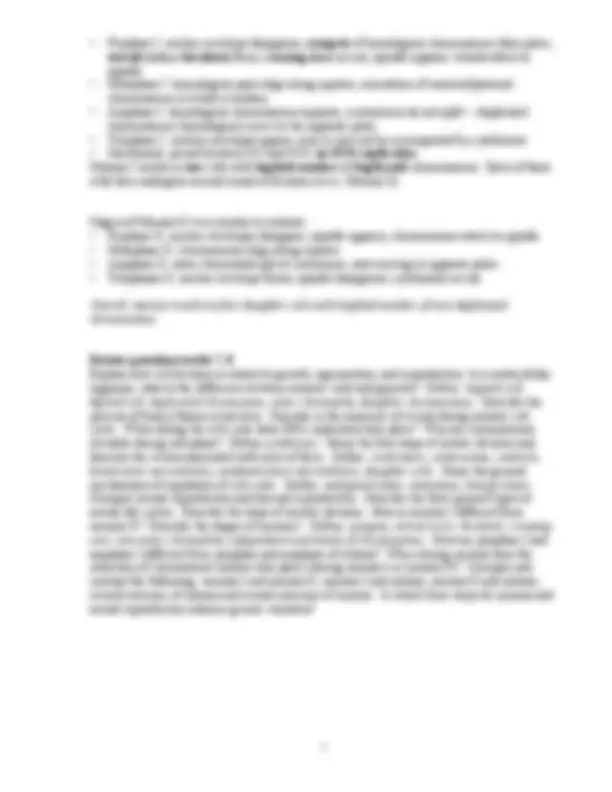Bio. Sci. 1 Week#7/8 lectures - outline
Topics: Chromosomes, Cell Cycle, Cell Division (mitosis and meiosis)
1. Cell division. Why cells divide: 1) Growth / regeneration; 2) Reproduction
2. In prokaryotes, cell division equals asexual reproduction. Asexual cell division in bacteria
and their relatives is termed binary fission: it involves replication of the bacterial chromosome
(DNA), growth, and cytokinesis.
3. In multicellular eukaryotes, somatic cells (body cells; all but gametes) contain diploid (2n)
number of chromosomes (e.g., 46 in humans). Germ cells (gametes) contain hapliod (n) number
of chromosomes (e.g., 23 in humans). Chromosome is made of DNA and structural proteins
condensed/coiled together. Chromosomes become condensed and are only visible during cell
division, the rest of the time they exist in a form of chromatin (uncoiled, “loose” chromosome).
Prior to cell division each chromosome becomes duplicated, consisting of two sister
chromatids. Sister chromatids result from DNA replication process and are two identical
(condensed) DNA molecules
4. Somatic cell cycle:
G1 (growth) S (synthesis/replication of DNA) G2 (more growth) M (mitotic division)
(G1+S+G2) = a.k.a. interphase (no visible division)
5. Mitotic division: occurs during regular growth/development and/or regeneration of tissues.
Two events: 1) division of nuclear material = mitosis; 2) division of cytoplasm = cytokinesis.
Stages of mitosis:
• Prophase: nuclear envelope disappears; centrosomes (centrioles) move to opposite poles;
spindle fibers form; duplicated chromosomes become visible; their centromeres
(“constricted” parts of duplicated chromosomes) attach to spindle fibers
• Metaphase: spindle is fully formed, chromosomes are lined along cell’s “equator”
• Anaphase: centromeres divide; sister chromatids separate, and move to the opposite poles
• Telophase: spindle disappears; new nuclear envelopes form; chromosomes uncoil
Cytokinesis: starts during late anaphase. It happens differently in plants and animals.
Plants: cell plate formation. Animals: cleavage furrow (constriction).
Mitosis results in two daughter cells with diploid number of non-duplicated chromosomes
6. Regulation of the cell cycle (internal and external mechanisms). Cancer (when regulation
does not work). Malignant and benign tumors, metastasis.
7. Importance of meiosis in sexual life cycles. Karyotypes. Types of life cycles: haplontic life
cycle, diplontic life cycle, and alternation of generations.
8. Meiotic division: occurs when gametes are formed in reproductive tissues. Steps: 1) Meiosis I
and II = division of nuclear material; 2) cytokinesis = division of cytoplasm. Major features:
reduction of the normal (somatic, diploid) number of chromosomes; recombination of genetic
material due to crossing-over and independent assortment of homologous chromosomes.
Stages of Meiosis I:










